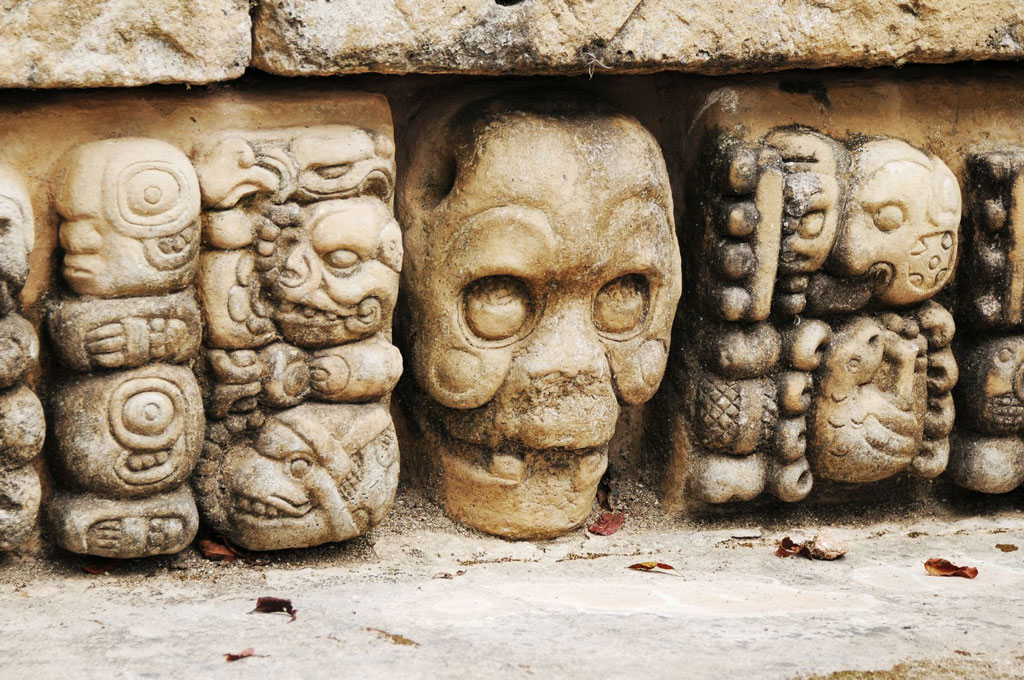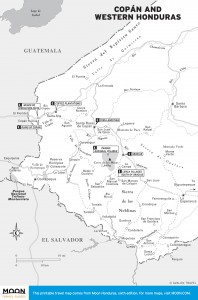
Stone carvings at the Ruins of Copán. Photo © Vojtech Vlk/123rf.

Copán and Western Honduras
Intricately carved Mayan ruins, tiny Lencan villages, impressive cloud forest, and the country’s highest mountain are all within this region, but it draws only a fraction of the tourists that flock to similar attractions in neighboring countries. Just a few miles from the Guatemalan border, the ruins of Copán are a must-see for visitors to Honduras. Built by a society of scientists and architects, artists and warriors, the ruins boast stelae (carved statues) and layers of temples, a ball court, and the famed Hieroglyphic Stairway, the longest hieroglyphic inscription found anywhere in the Americas. More than a millennium old, the ruins have been well preserved, in part thanks to their isolation. In the hills around Copán are the villages of Chortí Maya, a people related to their highland cousins to the northwest in Guatemala.An hour away is Santa Rosa de Copán, with its cobblestone streets, colonial buildings, and renowned cigar factory. Those whose visit coincides with Semana Santa will have the chance to observe the centuries-old traditions of colorful sawdust carpets over which solemn processions march, while visitors in the month of August will be treated to special festivities in honor of the town’s patron saint.
Travels farther south are well worth the effort, taking visitors farther off the beaten path. This is Lenca territory, the land of Lempira, a famed Indian chief who battled the conquistadors to a standstill before being tricked and killed, and for whom the national currency is named. This is one of the most naturally beautiful and least explored areas in all of Central America. Here, the adventurous can lose themselves for weeks, traveling the mountain roads and footpaths between the colonial town of Gracias and remote villages like Erandique, La Campa, and Belén Gualcho, or climbing to the cloud forests of Sierra de Celaque, which boasts Honduras’s highest peak, Cerro de las Minas, which reaches 2,849 meters (9,347 feet).
While tourist services exist in a number of spots—Copán Ruinas, Gracias, Santa Rosa de Copán, San Juan, La Esperanza—there are many untouched areas where the lack of creature comforts is more than compensated for by the thrill of visiting lovely villages seemingly lost in the mists of history, where locals may not know quite what to think of a passing foreigner but will invariably invite him or her in for a cup of strong black coffee and a chat.
Much of the mountainous region is still covered with ocote pine forest, mixed in with oak and liquidambar (sweet gum) at higher elevations and cloud forest on the peaks, although deforestation is a serious problem in many areas, as campesinos (peasants) cut wood for fuel or to clear more farm or grazing land.
The rainiest months in western Honduras are June, August, and September, but wet weather can hit at any time in the mountains. If you’re planning on camping, come prepared to get wet. The temperature is normally quite comfortable—warm in the daytime and pleasantly cool at night—although it can get downright cold in La Esperanza and surrounding hills.
While a visit to the primary ruin site at Copán takes just a couple of hours, it takes three full days to do justice to the region, with its multiple Mayan sites, hot baths, coffee farms, and other tourist attractions. The real Mayan buff will want to spend another day or two to see the smaller city of El Puente, near La Entrada, and less-frequented sites in the hills surrounding Copán.
It’s easy to become seduced by this beguiling region of scenic mountains and friendly countryfolk, and want to see more than Copán. The town of Gracias is a good jumping-off point for hikes in the cloud forests of Parque Nacional Celaque and explorations of the nearby Lencan villages. A cursory visit to admire Gracias’s colonial architecture, visit a couple of the nearby villages, and take a short hike at Celaque can be made with just a couple of days. Those with more time can summit Celaque in a two-day trip, hike the footpaths between the villages of La Campa and San Manuel Colohete, or spend a couple of days or more exploring the far-flung villages past Gracias toward El Salvador, like Erandique or San Juan.
Santa Rosa de Copán is the capital of the department of Copán and the unofficial capital of western Honduras. Although it doesn’t boast much in the way of tourist attractions, it’s a pleasant colonial town with good restaurants and hotels, and a convenient base for transport. (The town’s one shortcoming might be its traffic, due to the narrowness of those colonial streets.) Holy Week (the week leading up to Easter) and during the patron saint festival in late August are especially good times to visit. The main overland travel transport route into western Honduras from Guatemala is via Copán. Those who come in by Nueva Ocotepeque, from either Guatemala or El Salvador, should consider taking an extra day to hike into Reserva Biológica El Güisayote.
Most of the destinations in western Honduras can be visited without guides. However, several companies offer more specialized trips that may appeal to some travelers.
In Copán Ruinas, Basecamp (tel. 504/2651- 4695) and Yaragua Tours (tel. 504/2651-4147) offer a variety of adventuresome tours, including hikes and visits to the hot springs or a coffee plantation. The Asociación de Guías Copán (tel. 504/2651-4018), with its office right at the ruins, has guides who specialize in archaeology, history, nature, and even shamanism, and who can speak Spanish, English, French, and Italian (German too, if guide Antonio Ríos is around).
Max Elvir, a tireless promoter of tourism in western Honduras, runs Lenca Travel (tel. 504/9997-5340, [email protected] or [email protected]) in Santa Rosa, offering tours of surrounding villages and natural areas, including Celaque, Monte Quetzal, and Belén Gualcho; farther afield to Celaque, Gracias, La Campa, San Juan, and Erandique; and any other place you might want to visit. Max works exclusively with small groups, and his tours are all customized to the interests of the traveler, and can even include learning about medicinal plants or a culinary class if the visitor is so inclined. A day tour to Belén Gualcho, Corquín, and an organic coffee farm runs US$25 per person for a group of four or more. If you have your own wheels, Max charges US$75 a day for guiding services. There is also an association of guides that can be contacted through Santa Rosa’s tourism office (tel. 504/2630-1249), but these should be booked in advance, as many have other jobs as well.
In Gracias, an excellent community tourism network has been developed. Extensive information on the region can be found on the website, and the Asociación de Guías Turísticos Colosuca–Celaque can do city tours, countryside tours, national park tours, or any combination thereof. The association’s coordinator is Marco Aurelio Rodríguez (tel. 504/2656-0627 or 504/9870-8821, [email protected]).
Excerpted from the Sixth Edition of Moon Honduras & the Bay Islands.